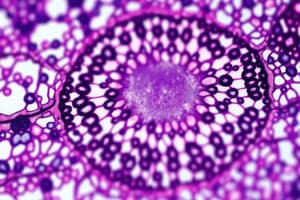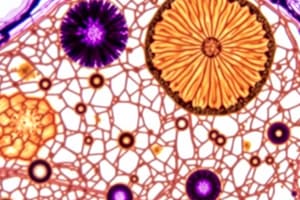Podcast
Questions and Answers
What is the primary purpose of dehydration in tissue sample preparation?
What is the primary purpose of dehydration in tissue sample preparation?
- To maintain tissue structure and morphology during electron microscopy
- To support the tissue sample during sectioning and provide a rigid structure for microtomy
- To remove water from tissue samples to prevent tissue degradation and facilitate infiltration with an embedding medium (correct)
- To replace dehydrating agent with a solvent that allows for infiltration of the embedding medium
What is the most commonly used clearing agent in tissue sample preparation?
What is the most commonly used clearing agent in tissue sample preparation?
- Chloroform
- Ethanol
- Xylene (correct)
- Acetone
What is the importance of dehydration in tissue sample preparation?
What is the importance of dehydration in tissue sample preparation?
- It supports the tissue sample during sectioning and provides a rigid structure for microtomy
- It maintains tissue structure and morphology
- It prevents tissue shrinkage and distortion, and allows for uniform infiltration of the embedding medium (correct)
- It enables the embedding medium to penetrate the tissue evenly
What is the purpose of embedding in tissue sample preparation?
What is the purpose of embedding in tissue sample preparation?
What is the importance of clearing in tissue sample preparation?
What is the importance of clearing in tissue sample preparation?
What is the most commonly used embedding medium in tissue sample preparation?
What is the most commonly used embedding medium in tissue sample preparation?
What is the primary advantage of using acetone over ethanol in the dehydration process?
What is the primary advantage of using acetone over ethanol in the dehydration process?
Which solvent is used to remove ethanol or acetone from dehydrated tissues during the clearing process?
Which solvent is used to remove ethanol or acetone from dehydrated tissues during the clearing process?
What is the primary reason why chloroform is often used for clearing tissues, especially for paraffin wax embedding?
What is the primary reason why chloroform is often used for clearing tissues, especially for paraffin wax embedding?
What is the primary advantage of using plastic resin as an embedding medium for electron microscopy?
What is the primary advantage of using plastic resin as an embedding medium for electron microscopy?
What is the primary reason why gelatin is used for embedding small tissue samples, especially for frozen sectioning?
What is the primary reason why gelatin is used for embedding small tissue samples, especially for frozen sectioning?
What is the primary consequence of inadequate dehydration during tissue sample preparation?
What is the primary consequence of inadequate dehydration during tissue sample preparation?
What is the primary requirement for the solvents used in the clearing process?
What is the primary requirement for the solvents used in the clearing process?
What is the primary benefit of using a hydrophobic embedding medium during tissue sample preparation?
What is the primary benefit of using a hydrophobic embedding medium during tissue sample preparation?
Flashcards are hidden until you start studying
Study Notes
Dehydration
- Purpose: to remove water from tissue samples to prevent tissue degradation and facilitate infiltration with a embedding medium
- Methods:
- Ethanol series: 70%, 80%, 90%, 95%, and 100% ethanol
- Acetone: used for fatty tissues or when ethanol is not effective
- Automated tissue processors: use a combination of ethanol and acetone
- Importance:
- Prevents tissue shrinkage and distortion
- Allows for uniform infiltration of the embedding medium
Clearing
- Purpose: to replace dehydrating agent with a solvent that allows for infiltration of the embedding medium
- Methods:
- Xylene: most commonly used clearing agent
- Toluene: alternative to xylene
- Chloroform: used in some automated tissue processors
- Importance:
- Enables the embedding medium to penetrate the tissue evenly
- Helps to remove any remaining dehydrating agent
Embedding
- Purpose: to support the tissue sample during sectioning and provide a rigid structure for microtomy
- Methods:
- Paraffin wax: most commonly used embedding medium
- Plastic resin: used for electron microscopy and special applications
- Frozen sectioning: uses a frozen tissue sample and no embedding medium
- Importance:
- Maintains tissue structure and morphology
- Allows for thin sectioning and high-quality microscopy
Tissue Preparation
Dehydration
- Removes water from tissue samples to prevent degradation and facilitate embedding medium infiltration
- Methods include:
- Ethanol series (70%, 80%, 90%, 95%, and 100%)
- Acetone (for fatty tissues or when ethanol is ineffective)
- Automated tissue processors (combining ethanol and acetone)
- Prevents tissue shrinkage and distortion, ensuring uniform embedding medium infiltration
Clearing
- Replaces dehydrating agents with a solvent to allow embedding medium infiltration
- Methods include:
- Xylene (most commonly used clearing agent)
- Toluene (alternative to xylene)
- Chloroform (used in some automated tissue processors)
- Enables even embedding medium penetration and removes remaining dehydrating agents
Embedding
- Supports tissue samples during sectioning and provides a rigid structure for microtomy
- Methods include:
- Paraffin wax (most commonly used embedding medium)
- Plastic resin (for electron microscopy and special applications)
- Frozen sectioning (uses frozen tissue samples with no embedding medium)
- Maintains tissue structure and morphology, allowing for thin sectioning and high-quality microscopy
Dehydration
- Dehydration removes water from tissue samples to prepare them for infiltration with a hydrophobic embedding medium.
- Methods of dehydration include:
- Ethanol series: Gradual replacement of water with increasing concentrations of ethanol (e.g., 70%, 95%, 100%).
- Acetone series: Similar to ethanol series, but using acetone as the dehydrating agent.
- Automated tissue processors: Combine heat, vacuum, and solvents to dehydrate tissues.
- Importance of dehydration:
- Prevents ice crystal formation during freezing.
- Allows for infiltration with embedding medium.
Clearing
- Clearing removes dehydrating agents and replaces them with a solvent that allows for infiltration with the embedding medium.
- Methods of clearing include:
- Xylene or toluene: Used to remove ethanol or acetone from dehydrated tissues.
- Chloroform: Used to clear tissues, especially for paraffin wax embedding.
- Benzene: Used to clear tissues, but has largely been replaced by safer alternatives.
- Importance of clearing:
- Solvents used in clearing must be compatible with the embedding medium.
- Ensures complete removal of dehydrating agents.
Embedding
- Embedding surrounds the tissue sample with a medium that provides support and allows for sectioning.
- Methods of embedding include:
- Paraffin wax: Most commonly used embedding medium, provides a firm matrix for sectioning.
- Plastic resin: Used for electron microscopy, provides a more stable and durable matrix.
- Gelatin: Used for embedding small tissue samples, especially for frozen sectioning.
- Importance of embedding:
- Provides a stable matrix for sectioning.
- Allows for precise control over tissue orientation and section thickness.
Studying That Suits You
Use AI to generate personalized quizzes and flashcards to suit your learning preferences.




